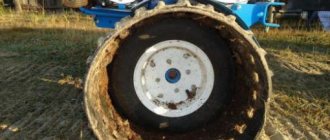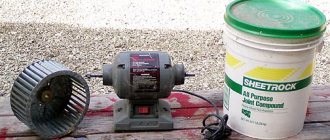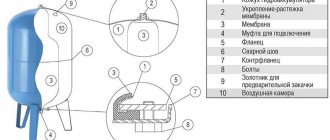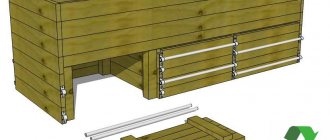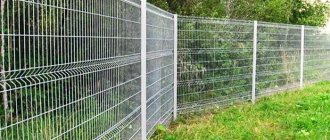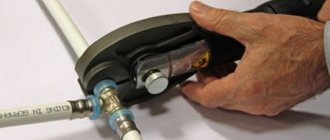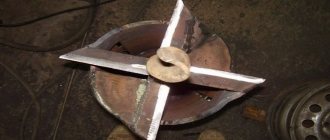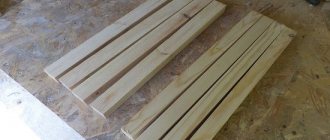How is pipe bending done?
Bending tubular products most often requires relatively little force, so industrial equipment is rarely used in such work. But the design of the pipe bender must be such that the pipe cross-section does not deform during the bending process.
Deformation can occur for the following reasons:
- The bending angle exceeds 10-15°. In this case, the inner part of the profile is excessively compressed, and the outer part is stretched. Because of this, the pipe is deformed and may crack.
- High carbon content in steel alloy (all grades starting from steel 40). The material is very elastic, so it can spring back when bent. If the contour of the product has a complex shape, the spring force can be 15-20%.
- Distortion of the end of the pipe if it is not securely fixed. The end takes a different position, its perpendicularity to the axis is completely lost. Such a pipe may not be able to be installed into the structure after bending.
Therefore, first you need to work out in detail the scheme according to which the profile bending will be made with your own hands; drawings, photos, videos will help you choose the optimal type of structure.
It is better to use ready-made drawings developed by engineers for the appropriate profile section. To avoid deformation, it is also important to choose suitable steel grades. The hot rolled profile is best suited for bending.
The easiest way is to assemble a manual pipe bender with your own hands. This unit is ideal for bending workpieces produced in accordance with GOST 8732-76. The part must not have a seam.
Products made from soft alloys of non-ferrous metals are also suitable. The workpiece must be free of corrosion and scale, otherwise the force will be distributed unevenly.
Make your own crossbow pipe bender with a punch
They are called pipe bending machines because of their similarity with a type of weapon such as a crossbow. Only instead of arrows, a hydraulic jack is used, acting on the profile or pipe, bending them. To construct a crossbow-type pipe bending machine, you will need to use a welding machine. To implement the idea you will need to perform the following steps:
- A frame of a cone-shaped design is manufactured. For this, corners, channels, profiles, etc. are used.
- Two steel plates are connected using movable rollers, through which the part is bent
- Inside between the rollers there is a jack on which a C-shaped shoe or punch is placed
- The shoe must have grooves to prevent the tube or profile from slipping
This is interesting!
You can buy a punch or make it yourself.
For manufacturing, you will need a tube from which the seat for the material to be bent is made. It is recommended to use such pipe benders for bending pipes, since other shapes of products will simply be deformed using such a machine. It is not difficult to make such a device, but you will need a hydraulic jack for this.
The video below shows how to make a crossbow pipe bender on your own.
Manual pipe bender device
Before manufacturing the product, you should draw up a drawing of a pipe bender for a profile pipe with your own hands or use a ready-made one. There are quite a lot of ready-made drawings for profile benders of various configurations.
The diagram should include the following main components of the tool:
- Replaceable profile roller for crimping.
- Lever for deforming the pipe.
- End fastening. The end fixation should be as reliable as possible.
- A template with the ability to adjust bending parameters or a lever movement limiter.
- Protective housing.
- Base.
You can make a drive pipe bender with your own hands; the drawings in this case should also include a method for fixing the drive. This unit will allow you to work with profiles with thick walls.
It is better to use a hydraulic motor, it works quietly and autonomously, and also provides optimal precision.
Vertical axes and accessories must be located in rolling bearings. Almost any workbench or other reliable support can be used as a base. The simplest homemade pipe bender can be built with your own hands without a separate bending unit.
In this case, bending will be performed in a composite template, the elements of which are gradually moved in the correct direction to achieve the required bend. But, this option is only suitable for profiles with small wall thickness and small bending angles.
You can make various pipe benders for profile pipes with your own hands, differing in the method of generating force and functionality.
For simple tasks, the easiest way is to build a hand-held template tool. Its assembly requires a minimum of parts, and there are also many ready-made drawings.
Note!
Do-it-yourself compressor: selection of materials and tools for assembly at home + step-by-step instructions for making and assembling yourselfHomemade products for the garage with your own hands: options for products for arranging a garage, detailed diagrams and drawings for creating with your own hands
- Do-it-yourself press - design features, choice of manufacturing materials. Step-by-step instructions for making it yourself + simple diagrams and drawings
Do-it-yourself manual pipe bender, how to make the simplest option
A simple machine for bending pipes can be made from available materials, using not only metal, but also wood. Finding an unnecessary board on the farm is much easier than finding a steel base of the required thickness. To begin with, take a board, the thickness of which should be thicker than the diameter of the material to be deformed. Further instructions for making a simple pipe bender from boards are as follows:
- An arc-shaped template is cut out of the board. The shape should be such that the bending radius of the equipment should be obtained in the end
- Attach the resulting template to the base in the form of a sheet of 2-3 sheets of fiberboard or chipboard. It is very important that the template is firmly fixed to the base, since it may come off during the bending process. Additionally, you can use a clamp or small vice for fixation.
- A stop should be secured at one edge, through which the bent material will rest. As such a stop, you can use a piece of board attached to the base.
Using such a device is not difficult, and to do this, you should insert material between the template and the stop and, making sure that the pipe does not jump off, begin work. The principle of manufacturing a simple pipe bender does not require any financial investment, and this method is perfect when you need to bend a small number of profiles. There are other options for making simple pipe benders with your own hands from improvised materials, which are described below.
Template homemade pipe bender
The most basic method of making a pipe bender with your own hands is to use template bending technology. For household tasks, such a tool is usually sufficient. It even allows for spatial bending.
To reduce the force, it is advisable to heat the workpiece to a high temperature in the area of future curvature. Heating can be done with a gas or gasoline burner. Thanks to this, the plasticity of the metal will increase, and accordingly it will be easier to bend it.
To make a pipe bender with your own hands using a template method, you need to make the following components:
- A clamp in the form of an anchor for inserting a pipe.
- Mobile (replaceable) support with a groove in the axis. The groove must correspond to the arc of the outer diameter of the profile.
- Mounting base with holes.
A bevel is made on the reverse side of the structure. Its angle must correspond to the angle that must be given to the pipe during the bending process. For the manufacture of structural elements, ordinary structural steel, for example, grade 45, is suitable. But for the stop it is better to use stronger and stiffer steel, for example, U10A.
Before work, it is advisable to visually study the design that a do-it-yourself pipe bender should have; videos and photographs will help you avoid mistakes and unnecessary consumption of materials. Assembly is quite simple.
Note!
- Do-it-yourself winch: classification, manufacturing materials, description of work stages + instructions for DIY construction
Do-it-yourself clamp - step-by-step production and description of options for using a clamp
DIY knife | A step-by-step description of how and from what materials to make a homemade knife
A clamp is mounted on the support pipe. The emphasis is also fixed to the support; it is important to ensure its alignment with the clamp. The distance between nodes is calculated based on a predetermined range based on the ratio R/d (radius and diameter of the pipe).
It is advisable to use the parameters of the radius of curvature provided by GOST 17685-71:
- S/d<0.03 – from 4d;
- S/d<0.06 – from 3.6d;
- S/d<0.11 – from 3d;
- S/d<0.16 – from 2d.
The above parameters are relevant for cold bending. If you heat the workpiece, the values can be reduced by 12-15%. The pipe bender has no restrictions on the maximum bending angle. But, if it is higher than 45°, folds will appear on the product, and the profile itself will lose its original cross-sectional shape.
How to bend a pipe correctly without special equipment
If it is not possible to make a homemade pipe bending machine, then the task can be accomplished without a special machine or equipment. We’ll look at how to bend a round pipe or profile without using pipe benders below. There are the following ways to do this:
- The simplest is to clamp the pipe between two posts (they should be stronger than the material being bent) and bend to the required amount
- Fill the pipe or profile with sand, heat the bend with a blowtorch, and then bend it manually. Heated metal is easily deformed, but the main thing here is not to overdo it. This method is popular among heating system installers, when steel pipe bends were obtained in this way
- Use a grinder and welding. If the pipe has a large diameter, then the easiest way to bend it is to make cuts at the site of the future bend and bend it. To restore the strength of the material, the remaining space of the cut area should be welded
There are a sufficient number of methods for bending pipes and profiles, and to implement them you do not need to pre-fabricate bending devices. However, such methods are rational only in one case, when it is necessary to perform work in a single quantity.
Roller pipe bender
Another simple way to build a pipe bender with your own hands for a profile pipe is to use a roller structure. This tool gives you more options and ensures almost perfect accuracy. Has the following components:
- A roller mounted on a vertical axis. Rotation must be free.
- Swivel lever with handle.
- A replaceable roller that does the bending itself. Mounted on the reverse arm of the lever.
- Thrust node.
- Bed.
Free rotation of the roller ensures minimal effort. Therefore, rolling bearings should be used. It should be possible to quickly replace rollers to change the bending angle.
Note!
DIY vices: simple and reliable homemade vices from A to Z (190 photos)Do-it-yourself vibrating table - selection of materials, components and assemblies for a vibrating table with a step-by-step manufacturing description
Do-it-yourself grain crusher - operating principle, types and features of creating a device for processing grain crops
The radius of curvature with this technology coincides with the radius of the roller that bends the workpiece as the stop moves. There must be no runout on the axes, otherwise the accuracy will sharply decrease.
Manual pipe bender on a roller mechanism
Making a manual pipe bender on rollers with your own hands is somewhat easier, since there are fewer mechanical elements. The device allows you to bend pipes in certain places.
The device must have a long lever, since direct manual force is required to bend the products.
Winding pipe bender
You can also design a winding pipe bender with your own hands for a round pipe or square profile, which works in a similar way to a roller tool. But bending is performed not with a rotary roller, but with a movable stop. To move the stop, horizontal guides are installed.
The design includes the following parts:
- Profile sector. The maximum bending angle will depend on its angle.
- The vertical axis is short. A bearing must be used for free rotation.
- 2 adjacent rollers forming a movable stop.
- Guides with one functional side.
- Stop movement limiter. Prevents the risk of the stop moving arbitrarily when bending.
- Fuse plug installed on the profile sector. Allows you to correctly fix the part and increase the accuracy of your work.
The mechanism is more complex to manufacture, but is more compact in size. The pipe bender is easier to use due to the ability to quickly change the position of the clamping unit. Can be equipped with an electric drive or a hydraulic unit.
Types of pipe benders
The design under consideration can be classified according to a fairly large number of characteristics. There are universal versions on sale, as well as for narrowly targeted applications. The device differs in the following ways:
- By drive type. An important design element is the drive, which can be hydraulic, electric, manual or electro-hydraulic. Recently, the electric drive has become more widespread, as it is compact and very efficient. Hydraulic is more efficient, but it is difficult to operate, takes up a lot of free space and requires periodic maintenance. A manual pipe bender is distinguished by the presence of a mechanism that significantly increases the applied force. If we consider homemade options, then they make a manual pipe bender with their own hands. In addition, you can create an electric pipe bender with your own hands. But it’s almost impossible to make a hydraulic version yourself.
- Classification is also carried out according to the degree of mobility. There are stationary and portable design options. In most cases, a universal manual pipe bender is designed as a portable structure. A homemade pipe bender for a round pipe can be attached to the base in various ways. It is worth considering that during the execution of work, part of the resulting stress is transferred precisely to the base. Therefore, when creating a homemade version, you need to ensure reliable fixation of the device.
- According to the method of influence on the workpiece - the main sign of classification. For example, a crossbow-type pipe bender has its own special design, which is suitable for bending metal or metal-plastic pipes. In addition, there is a design that works on the principle of running, winding or rolling.
DIY pipe bender
A homemade pipe bender for metal-plastic pipes can be of various types, but most often they create a mechanical type, when, due to a special design, the transmitted force increases several times.
Crossbow pipe bender
The instrument is smaller in size, but has a more complicated design. The part rests on 2 rollers, rigidly attached to the body. The distance between the rollers directly affects the bending radius.
The design is equipped with a built-in manual hydraulic cylinder (you can use a cylinder from the brake system of a car). When the trigger is released, under the influence of hydraulic force, the cylinder rod presses on the pipe, pressing it against the rollers and bending it. The rollers and hydraulic cylinder are mounted on a single support, so the quality of the assembly directly affects the bending accuracy.
The advantage of the tool is that the master does not need to apply physical effort. The latter is created by hydraulics. Instead of a cylinder, you can use a simple jack.
But, making such a pipe bender for a round pipe with your own hands is much more difficult, since it is necessary to construct a supporting frame. The dimensions of the latter must strictly correlate with the dimensions of the hydraulic element in order to achieve high precision of work.
How to build a machine for bending pipes and profiles at home from a winch
The methods described above have one significant drawback - they do not allow bending large materials. To be able to deform profiles and large diameter pipes, you should use a winch. The principle of manufacturing a pipe bender using a winch is as follows:
- Initially, a template is prepared from chipboard, which should be shaped like the bending radius of the metal profile
- A stop is used to secure the material at one point. As such, a board screwed to the base or a clamp is used
- A winch hook is attached to the other end of the pipe. The winch must be securely fixed to a wall or concrete base. When the winch handle is activated, the material is deformed
This method eliminates the need for physical effort, since this task is assigned to the winch. When constructing the device in question, it is important to observe safety precautions. One of the big dangers is that the hook may break during bending. To prevent this from happening, you should fix it as best as possible.
Hydraulic pipe bender
It operates on the basis of a hydraulic drive that generates the required force. Any car jack will do. Channels are used to mount the frame. Bending is carried out on two stops mounted strictly symmetrically. You can make a tool with the ability to adjust the position of the stops.
Replaceable equipment is mounted on the jack rod. The latter profile must coincide with the diameter of the arc of the outer section of the pipe. The greater the distance between the frame stops, the wider the bend.
The jack is installed at the top of the structure so that it presses the workpiece from above. The pipe must be securely fixed to the stops so that the angle exactly matches the specified one.
If you plan to bend parts with a large cross-section, it is better to fix them with bolts. This will avoid the risk of injury if the workpiece comes off the tool.
Snail pipe bender
The design includes a fork that moves along guides. Due to the movement of the fork, the position of the roller changes and bending is carried out. The guides must have limit stops.
The rollers are mounted in suitable sized holes, which must first be made in the fork. Bending produces a small roller, and a large one fixes the workpiece. To move the fork, a strong handle is made on its reverse side.
Pipe bender assembly steps:
- Making a fork for pressing the roller.
- Making or purchasing rollers of suitable sizes.
- Install the rollers on the fork. Fastening is best done using bolts. The structure must be removable so that the radius can be adjusted.
- Make a frame from a sheet of steel with a thickness of 8 mm.
- Install the fork movement limiters on the guides.
Photo of ideas for pipe bending machines for DIY production
Below are options that will help develop your idea of making homemade pipe benders at home. You can assemble a pipe bending device not only manually, but also electrically. However, this is only relevant when you have to work with a large amount of steel materials every day.
Rolling machine for bending pipes from a jack
Design of rolling machine with gears
Simple pipe bending machine
Rolling machine to bend pipe
An interesting version of the simplest pipe bender
Pipe bender for bending decorative steel pipes
To summarize, it should be noted that having a pipe bender in the garage, there will never be a need to invent anything to bend the workpiece. The devices are especially popular among craftsmen who make arches, gates, and metal fences. These craftsmen will need more than one machine, since in addition to pipes and profiles, there is a need to bend steel rods, fittings, squares, etc. Having once taken the time to make a pipe bender, you will never again have the need to think every time where and how you can bend a tube or profile.
Pipe bender from car hubs
Finding a sufficient number of rollers of different diameters or making them yourself is quite difficult. Therefore, craftsmen often use hubs from a car.
The disadvantage is that the tool is massive, but it turns out to be more versatile, reliable and stable. Can be used for bending profiles with thick walls.
The structure consists of:
- 3 hubs. 2 must move, the latter is fixed rigidly along the axis of the device.
- 2 axles welded short axles.
- Rotary mechanism for adjusting the distance between the hubs.
- Axis guide. You can use a channel.
- Restrictive elements.
- Internal channel used as a guide. Must have limiters.
- Rotary handle.
Features of a homemade pipe bender
In order for the product to be of high quality, the profile cross-section should not change when bending. Therefore, the design of the pipe bender must be carefully calculated.
If the tool is not designed correctly, parts will develop sweet spots and cracks, reducing their strength.
A simple pipe bender should include the following components:
- Frame. It is best to make it from channel wood.
- Rollers for pipe feeding, mounted on different sides of the frame.
- Feeding unit consisting of a screw and a handle.
- Support parts mounted in the middle of the frame.
- Feed handle connected to rollers.
It is quite easy to build such a tool at home. It is better to fasten parts with bolts to increase reliability. The optimal base for the tool is a bench.
The clamping unit must be made on the basis of a screw in order to accurately control the bending angle. This way, you can perform high-quality and precise bending of almost any pipe in your home workshop.
Pipe benders for quick greenhouse construction
If you need to make a greenhouse at home, then it is not at all necessary to make a homemade device for bending pipes and profiles or even buy one. There is a simple way to learn how to bend metal parts in order to subsequently make a greenhouse out of them. Before considering this method, it should be noted that its disadvantage is that it takes a lot of time to achieve the result.
Considering that practically nothing is needed for this, then this drawback can be considered irrelevant. To bend a profile or pipe into a crescent shape to make a greenhouse, you will need to make a T-shaped pipe bender.
- Connect two pipes - one long one, which acts as a handle or holder
- The second tube is short - 10-15 cm. The diameter of this tube should be 1.5-2 times larger than the workpiece being bent
- To increase the strength of the connection between two tubes, it is recommended to thoroughly weld them, additionally using steel angles or plates
This method requires physical effort, and it is also inconvenient to implement, but if there are no other options, then this method works effectively and does not require the manufacture of a special machine.
